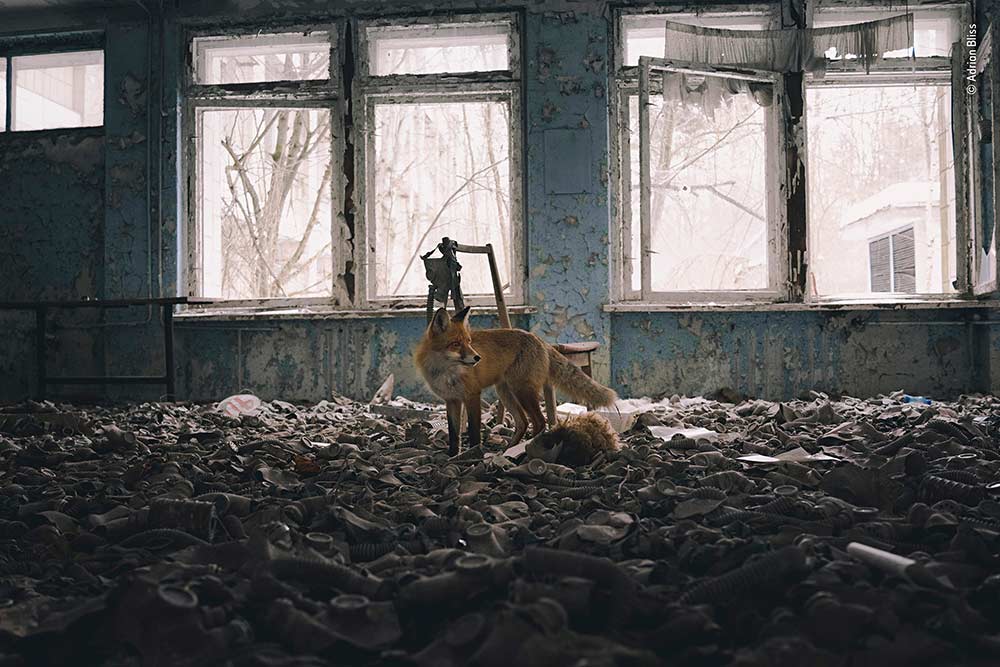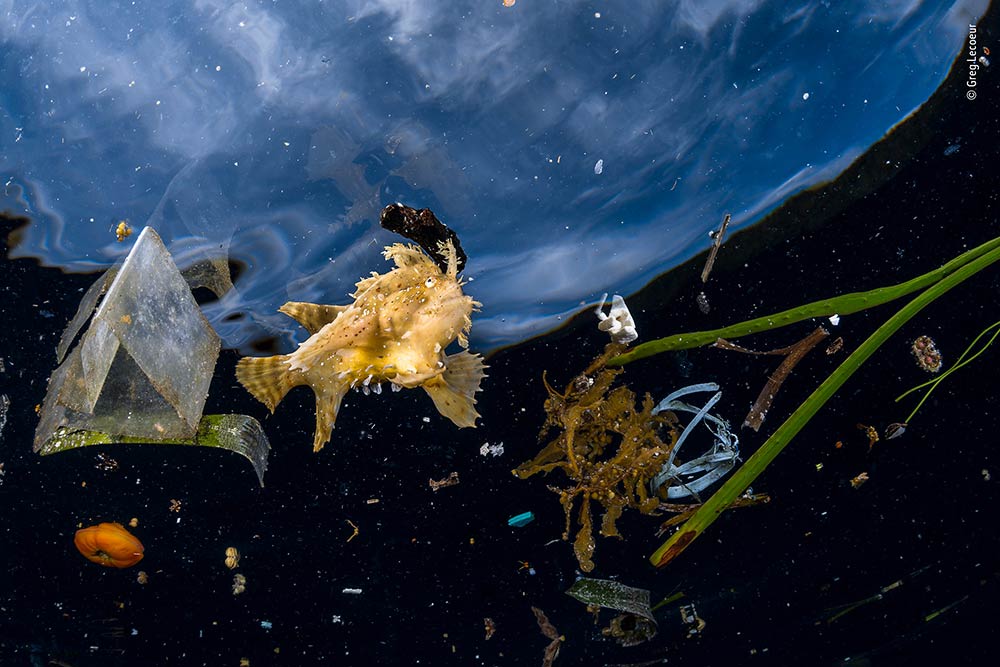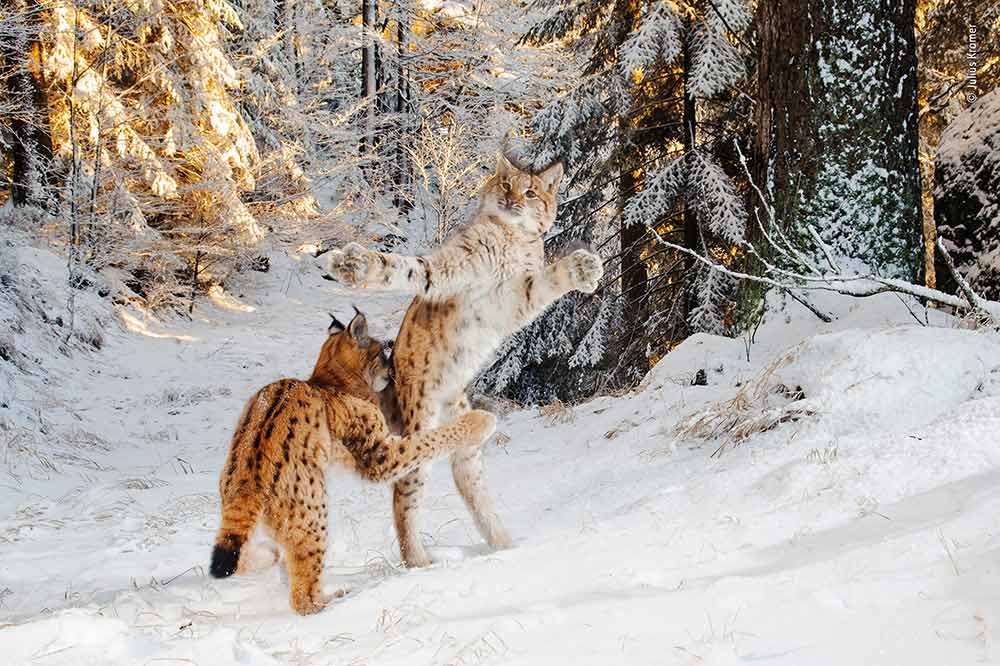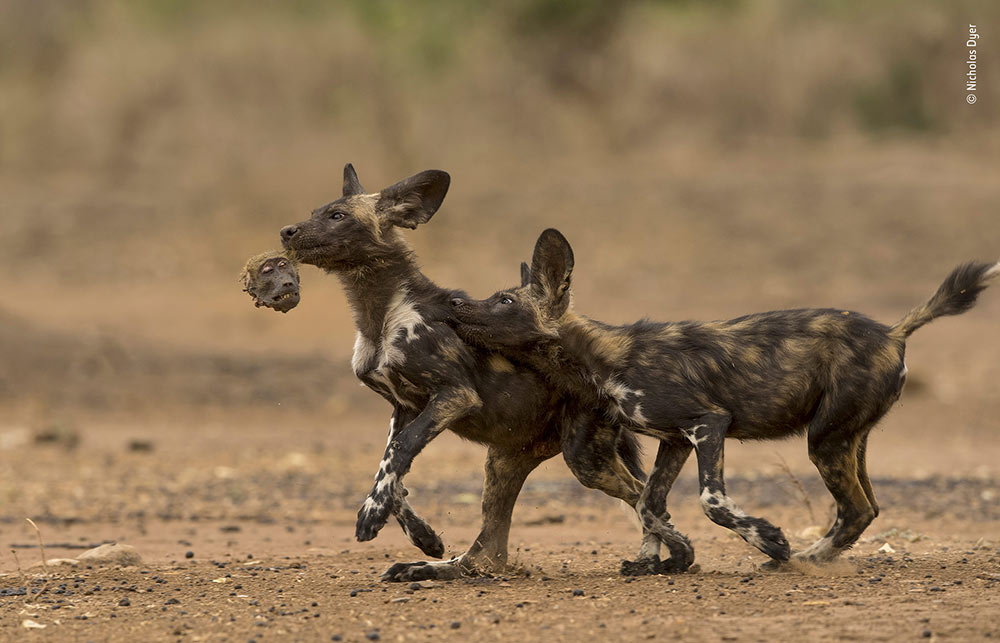 | « Back to article | Print this article |
A red fox in a derelict schoolroom, a Bengal Tiger in the forests of Bhutan and walruses are just a few of animals featured in the photos shortlisted for this year’s Wildlife Photographer of the Year.
"Wildlife Photographer of the Year showcases the world's best nature photography and photojournalism," explains the London's Natural History Museum, the institution that organises the competition and a world-renowned exhibition that starts on October 19 and runs until the summer of 2019.
The overall winners from 100 finalists selected out of more than 45,000 professional and amateur entries across 95 countries, will be announced on October 16.
While we wait for the results to be announced, here are some of the contenders in the contest.
(Please click on the images for full-screen resolution)

Highly commended 2018, 11-14 Years Old
When Adam first spotted the Titiwangsa horned tree lizard on the road near his home in the mountains of Pahang, Malaysia, it was in a furious life-and-death battle with a venomous Malaysian jewel centipede. There was a lot of chasing, writhing and thrashing about, and Adam was so fascinated that he completely forgot about his camera and simply watched. Only when the lizard finally overpowered the centipede did Adam think about framing a picture. He jumped into the ditch and crawled towards the lizard for an eye-level portrait of the victor standing over its prize.
Photograph: Adam Hakim Hogg/Wildlife Photographer of the Year 2018

Highly commended 2018, Urban Wildlife
Adrian was exploring the derelict schoolroom when the red fox trotted in, perhaps curious about the human or perhaps just on its rounds. It stopped briefly on the carpet of child-sized gas masks, just long enough for a picture, and then exited through a broken window. The school in Pripyat, Ukraine, was abandoned in 1986, as was the whole city, following the catastrophic explosion at the Chernobyl nuclear power plant, just 3 kilometres away. It was the worst nuclear accident in history, spreading radioactive fallout across Europe. Pripyat’s buildings are now decaying and have been looted (the gas masks – Cold War relics – were left as being of no value).
Photograph: Adrian Bliss/Wildlife Photographer of the Year 2018

Highly commended 2018, Plants and Fungi
The arms of immense trees stretched eerily into the mist permeating Madeira’s Fanal Forest. Among them was this low tilo branch with ferns growing all along it, 'like a forest within a forest’, says Antonio. The mighty tilo tree – an evergreen laurel which can reach more than 40 metres tall – is found only in Madeira and the Canary Islands. It is a dominant element of the island’s laurisilva – the largest relic of the laurel forest that once extended across southern Europe and northwestern Africa. Now threatened mainly by invasive species, this humid expanse is home to a wealth of plants and animals, many of them found nowhere else. Key to Antonio’s miniature forest was the hare’s foot fern, with broad, finely-divided fronds. It occurs in the western Mediterranean, Canary Islands and Madeira. Like other epiphytes (plants that grow on other plants), it garners water and nutrients from the air, rain or plant debris and relies on the host plant for support. As the breeze threaded through the trees, it stirred up the ubiquitous fog, frustrating Antonio’s desire for a uniformly intense backdrop. But in a moment of calm, he realized the simple elements of his composition, isolated against pure white.
Photograph: Antonio Fernandez/Wildlife Photographer of the Year 2018

Highly commended 2018, Behaviour: Invertebrates
By 1 am, the forest in Thailand's Peninsular Botanic Garden was quiet, but in the leaf-litter, its nightlife still shone. The star of the show was a large firefly larva, about 8 centimetres (more than 3 inches) long, which emitted a continuous glow from four light organs at its rear. Fireflies spend most of their lives as larvae, feeding mainly on slugs and snails. This one can even tackle invasive African land snails many times its own size. Its glow – the result of a chemical reaction in its light organs – is most likely a warning to predators that it is unpalatable (whereas, the flashing lights of adult fireflies are for courtship).
Photograph: Christian Wappl/Wildlife Photographer of the Year 2018

Highly commended 2018, Animals in their environment
The stench was unbearable as Emanuele searched the carcasses for life. Fed by the sea, the desert coast of Peru’s Paracas National Reserve teems with life. A colony of South American sea lions supplies the corpses --the result of illness, injuries (some from conflict with fisheries) or occasional die-offs triggered by El Niño events (when warming of the sea reduces prey availability). Many of the carcasses were flat or too close to the sea, but eventually Emanuele found his frame. A young male Peru Pacific iguana (distinctive black chevrons on its throat) had joined the feast within, sheltered from the harsh sun and wind. Lying on the beach, choked by the vile smell until the iguana peeped through the eye socket, Emanuele encapsulated the dependence of terrestrial life on the ocean.
Photograph: Emanuele Biggi/Wildlife Photographer of the Year 2018

Highly commended 2018, Wildlife Photojournalist Award: Single Image
As soon as he saw Emily, the sun bear hurried to the front of his filthy cage. 'Every time I moved, he would follow me.' He was just one of several sun bears kept behind the scenes at a zoo in Sumatra, Indonesia, in conditions Emily says were 'appalling'. Sun bears are the world's smallest bears, now critically endangered. In the lowland forests of Southeast Asia, they spend much of their time in trees, eating fruit and small animals, using their claws to prise open rotten wood in search of grubs. They are threatened by rampant deforestation and the demand for their bile and organs for traditional Chinese medicine. When this sun bear saw the keeper, he started screaming. It was a chilling noise. Even more chilling was the nearby taxidermy museum with its stuffed pangolins and Sumatran tigers.
Photograph: Emily Garthwaite/Wildlife Photographer of the Year 2018

Highly commended 2018, Animals in their environment
In a remote forest, high in the Himalayas of central Bhutan, a Bengal tiger fixes his gaze on the camera. The path he treads is part of a network linking the country's national parks -- corridors that are key to the conservation of this endangered subspecies but unprotected from logging and poaching.Emmanuel and a team of rangers climbed rugged terrain, with enough kit to set up eight still and eight video cameras along one route, in the hope of glimpsing a tiger pass by (there were just 103 in Bhutan at the last count. After 23 days (and hundreds of false triggers by leaves and high winds), he hit the jackpot: a magnificent male tiger, and from his distinctive stripe pattern, one previously unrecorded in Bhutan. The tiger inspected the kit closely before disappearing into the forest, leaving this rare image, as if looking to us to protect his realm.
Photograph: Emmanuel Rondeau/Wildlife Photographer of the Year 2018

Highly commended 2018, Wildlife Photojournalist Award: Single Image
This Sargassumfish couldn't hide among the litter. The nearby frond of Sargassum seaweed was a far cry from the free-floating rafts of the seaweed that more normally shelter this frogfish and many other specialized species. A master of camouflage and an ambush predator, the Sargassumfish stalks its prey on claw-like fins through the fronds of these floating islands, concealed by its tan colour and feathery outline. Greg spotted this individual when returning from a dive on the biodiverse reefs of the Indonesian archipelago of Raja Ampat. It is an area of the western Pacific Ocean where strong currents converge, bringing with them nutrients that sustain the rich biodiversity. The currents also collect and concentrate anything else that floats – including some of the millions of tonnes of plastic that end up in the oceans each year.
Photograph: Greg Lecoeur/Wildlife Photographer of the Year 2018

Highly commended 2018, Animal Portraits
A lioness drinks from a waterhole in Zambia's South Luangwa National Park. She is one of the Mfuwe Lodge pride -- two males, five females and five cubs. Isak had been keeping watch on them while they slept off a feast from a buffalo kill the night before. When this female got up and walked off, Isak anticipated that she might be going for a drink, and so he headed for the nearest waterhole. Though lions can get most of the moisture they need from their prey and even from plants, they drink regularly when water is available. Sure enough, the lioness appeared through the tall, rainy-season grass and hunched down to drink, occasionally looking up or sideways. With perfect timing, Isak caught her gaze and her tongue, lapping the water, framed by the wall of lush green.
Photograph: Isak Pretorius/Wildlife Photographer of the Year 2018

Highly commended 2018, Behaviour: Mammals
It had been more than a year since Julius set up his camera trap in Germany's Upper Bavarian Forest, and he had got just two records of Eurasian lynx. He was on the brink of giving up when a biologist colleague insisted that this was 'such a typical spot for lynx'. Like many solitary cats, the males have expansive home ranges, within which one or more females live. Julius went on to weather problems including failed batteries, humidity, deep snow and spider webs before his luck changed dramatically. Two six-month-old kittens turned up to play. Honing their hunting skills with joyful exuberance, they rewarded Julius with pictures and the hope that the population might be growing.
Photograph: Julius Kramer/Wildlife Photographer of the Year 2018

Highly commended 2018, Behaviour: Mammals
A pair of African wild dog pups play a macabre game of tag with the head of a chacma baboon -- the remains of their breakfast. The endangered African wild dog (aka the painted hunting dog) is best known for hunting antelopes, such as impalas and kudus. But over the past five years, in Mana Pools National Park, northern Zimbabwe, Nick has witnessed three different packs regularly killing and eating baboons – highly unusual, not least because baboons are capable of inflicting severe wounds. The hunting technique has been perfected by Blacktip, mother of the pups and the alpha female of the Nyakasanga pack. That morning, Nick had tracked a pack on foot for 3 kilometres (nearly 2 miles), taking in two failed impala hunts before the dogs finally seized a baboon. It wasn't enough to feed the whole pack, but it satisfied nine pups. They stopped short of the baboon's skull, and then the fun began. Nick, lying nearby, watched more than half an hour of chasing, tackling and tugs-of-war with the leftovers.
Photograph: Nicholas Dyer/Wildlife Photographer of the Year 2018

Highly commended 2018, Behaviour: Mammals
When an Anchieta's cobra reared its head and moved towards two meerkat pups near their warren on Namibia's Brandberg Mountain, the rest of the pack – foraging nearby – reacted almost instantly. Rushing back, the 20-strong group split into two: one group grabbed the pups and huddled a safe distance away, the other took on the snake. Fluffing up their coats, tails raised, the mob edged forwards, growling. When the snake lunged, they sprang back. This was repeated over and over for about 10 minutes. Tertius had a ringside seat from his vehicle and relished the chance to capture such intense interaction between the meerkat pack and the little known Anchieta's cobra. Focusing on the snake's classic profile and flicking tongue, he also caught the expressions of fear and aggression among the meerkats, some facing their attacker and one fleeing. Finally, the cobra gave up and disappeared down a burrow into the warren. The meerkats reunited and scurried away, most probably to an alternative – snake-free – warren in their territory.
Photograph: Tertius A Gous/Wildlife Photographer of the Year 2018

Highly commended 2018, Animal Portraits
It was a bright summer's night when Valter came across the walruses. They were feeding just off an island in the Norwegian archipelago off Svalbard. Putting on his wetsuit, and using a couple of monopod poles and a float to extend his camera in front of him, Valter slipped into the icy water. Immediately, a few curious walruses – mainly youngsters – began swimming towards him. Clumsy on land, these weighty giants now moved with ease and speed. Keeping at pole's length, he was able to take this intimate portrait of the distinctive whiskered faces of a youngster and its watchful mother..
Photograph: Valter Bernardeschi/Wildlife Photographer of the Year 2018

Highly commended 2018, Underwater
On the sandy seabed off the coast of Mabini in the Philippines, a yellow pygmy goby guards its home – a discarded glass bottle. It is one of a pair, each no more than 4 centimetres (1 and a half inches) long, that have chosen a bottle as a perfect temporary home. The female will lay several batches of eggs, while the male performs guard duty at the entrance. Setting up his camera a few centimetres in front of the bottle's narrow opening, Wayne positioned his two strobes – one at the base of the bottle to illuminate the interior, and the other at the front to light the goby's characteristic surprised face. Opting for a shallow depth of field, Wayne focused on the goby's bulging blue eyes, allowing the movement of the fish to blur the rest of its features into a haze of yellow, and framing its portrait with the circular entrance to the bottle.
Photograph: Wayne Jones/Wildlife Photographer of the Year 2018



